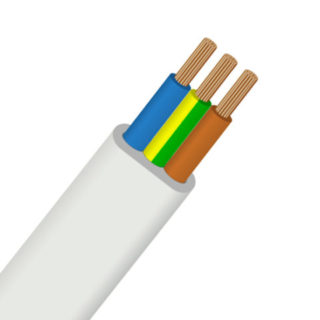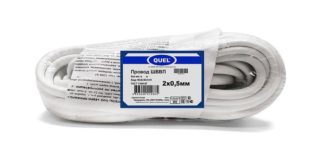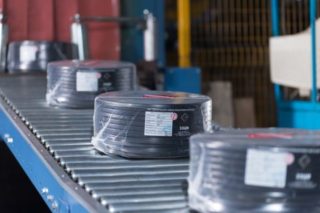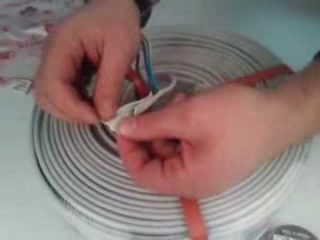In the home and office sphere, wires of the ШВВП brand are often used. These inexpensive devices have good quality and a number of characteristics, due to which they are used as cords and extension cords for most home appliances with low power. ShVVP cords are designed for a small amount of load, therefore they can be used only in domestic conditions and in offices. They are not suitable for creating the entire wiring system; it can only be used to connect individual sections of the lighting group or other devices.
Varieties of ball screw and its device
You can find a ШВВП conductor for sale in two versions - with copper conductors and bimetal. The latter consists of aluminum, which is coated with a copper layer. It is used extremely rarely due to its reduced properties. It costs less than a cord made entirely of copper.
Regardless of the type of conductor, the ball screw consists of the following parts:
- Shell. It is made of polyvinyl chloride.
- Insulating layer. It is made of PVC.
- There was a copper stranded core.
It is made with two or three veins. Flexibility class fifth.
Each core is painted in its own color for ease of installation. If the sheath is blue, it can be judged that this core is a zero wire. The yellow-green color is used for land. Brown or red has a phase wire.
The color of the phase may vary. You need to check everything according to the documentation or use a special tester to determine the purpose of the core. The wire itself is usually white. Some manufacturers produce the product in black. The cost does not depend on the color of the cord.
Labeling Explanation
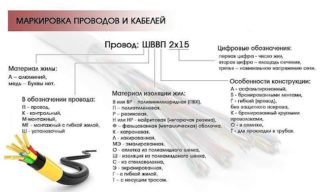 The name of the conductor is decrypted in a standard way as for any wires.
The name of the conductor is decrypted in a standard way as for any wires.
- Since the letter A is absent in the name, the material lived is copper.
- W - cord. It is a type of conductor with increased flexibility over conventional wires.
- B - PVC core insulation.
- B - PVC insulation of the cord sheath.
- P is flat.
After the main characters can also go descriptions of "H", "Ng" and others. They indicate additional string parameters. The most common letter additions include:
- L - tinned copper. Allows to simplify the soldering process. Reduces the risk of corrosion and other negative effects. Mounting - only using special terminals, non-removable fittings for use are prohibited.
- T - high temperature resistance of the cord. It can be used in conditions of high temperature and humidity. Do not install in direct sunlight due to the negative destructive effect on polyvinyl chloride insulation.
- Ng is non-combustible. It has a low emission of smoke and gas during combustion. It can also be denoted by the Latin letters LS.
After the letter abbreviation, the cross-sectional area and the number of cores in the cord are prescribed by a number. In addition, the year of manufacture is indicated. The final marking looks like ShVVP 2 × 0,5 2009 (a cord with two conductors with a cross-section of 0.5 sq. Mm. 2009 release).
Technical, mechanical and electrical specifications
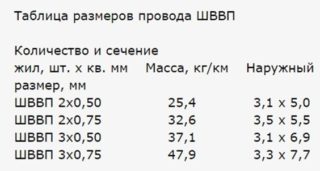 The main characteristics of the ball screw wire include the following:
The main characteristics of the ball screw wire include the following:
- Cross-sectional area. Cords of 0.5 sq. Mm are made. and 0.75 sq. mm. For this reason, such a conductor can only be used on a small load. On sale you can find products with a cross section of 1-6 sq. Mm. These values are not suitable for state standards, therefore, the above characteristics of the wire are not applicable to them.
- Number of cores.From can be 2 or 3. The veins must contain at least 7 copper wires.
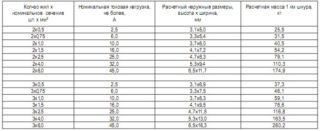
- Operating voltage 220/380 V.
- Insulation thickness. Minimum 0.5 mm; for the outer insulating layer, the minimum value is 0.6 mm. Shell color is usually black or white.
- Bending radius - 5 external diameters.
- Resistance to numerous bends. Withstands several tens of thousands of bends.
- The term of operation is 2 years. If you do not subject it to frequent bends, the operating time can be 10 years.
- Operating temperatures from -25 ° C to + 40 ° C.
- Frequency 50 Hz.
- Can withstand peak voltage of 2000W for up to 15 minutes.
- The specific resistance of 1 meter of cable reaches 270 Ohms.
- The capacity of the three-wire wire is 0.75 sq. Mm. is 1300 watts.
- Current load for a product with a cross section of 0.75 sq.mm. - 6A, for 0.5 sq. Mm. - 3A.
- The resistance is at least 0.012 MΩ for a conductor with a cross section of 0.5 square mm. and core temperature up to + 70 ° С. The length of the cord during measurements was 1000 m.
Insulation resistance is tested between the conductor and the ground and between two adjacent cores. Checking is carried out on a cord not less than 5 meters long. The conductor is placed in water, after which 2 kV voltage is supplied to it. As a result, leakage currents are measured. To check the insulation resistance between two cores, you need a length of 2 m or more. The shell must be cut between the conductors. Further, the wire is also lowered into the water, voltage is applied to it and the leakage current is measured.
Areas of use
The small cross-sectional area does not allow the use of ball screw for working with powerful installations. Due to the possibility of transmitting electric currents of a small size, a wire of different sections has found its application in the following areas:
- Installation of the lighting group indoors and out. For such purposes, a conductor with a cross section of 0.75 square mm is used. Withstand loads up to 750 watts.
- Connecting LED strips to a power source.
- Connect the ringer buttons to power.
- Products with three wires can be used to connect outlets with grounding with increased electrical safety.
- Creating extension cords. When connecting devices to it, it is important to monitor the total power. It should not exceed the value for which the ball screw is designed.
- Connecting low-power desktop electrical equipment (computers, telephones).
- Connecting household appliances up to 1300 watts (depending on the type of cord selected).
In the industrial field, due to its characteristics it is not used. Suitable for household and office use only.
An analogue of the product is a PUNP wire. It is prohibited for use, as it has insufficient characteristics for organizing the supply of electricity to household appliances and the lighting group. Also, from among the analogues, it is possible to distinguish a PVA wire with similar properties.
ShVVP cord supplies
For the device to work without interruptions, you need to be able to choose the right cable products. Be sure to pay attention to the correct labeling. It is applied according to GOST 7399-97 and should be indicated on the cord.
The wire must bear the manufacturer’s trademark, size and release date. Marking according to the requirements of GOST is applied every 500-550 mm. This rule may not be observed only if agreed with the buyer in the manufacture of products for reinforcement.
If the conductor is sold in bays, they must bear the appropriate label. It contains information about the product - designation, length, weight, name of the manufacturer, year of manufacture. Also, if the buyer requests, a technical control stamp may be applied.
The main manufacturers are Sevkabel and Electrocable.They produce high-quality and reliable products that meet all the declared characteristics.
Application features
The quality and duration of work depend on compliance with the features of using the cord. The high flexibility of the conductor makes it specific in connecting extension cords and electrical appliances. But to extension cords working with this cord, do not connect devices with a total load of more than 2 kW. Otherwise, the conductor will heat up above safe values, which increases the risk of a short circuit or fire.
Over time, frequent bends, especially at joints, can lead to insulation failure. Violation of the outer sheath is a signal to replace a portion of the wire with a working one.
The rules require that during installation, all cores are soldered and crimped with special tips. Only after completing this procedure can the conductor be connected to switching devices and meters. The need for crimping is connected with the multi-wire structure of the ball screw.
When connecting the cord to the plug, the installation must also be carried out correctly. It must be installed in such a way that the force is applied to the external insulation, and not to the conductive wires.
